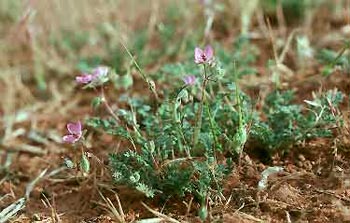Storksbill

Common Name(s):
Storksbill
Redstem filaree
Alfilaria
Filaree
Redstem storksbill
Scientific Name:
Erodium cicutarium (L.) L'Hér. ex Ait.
Scientific Name Synonyms:
None known
Symbol:
ERCI6
Description:
Life Span: Winter annual
Origin: Introduced
Season: Cool or Warm (dependant on climate)
Growth Characteristics: A low and spreading 2 to 5 inch tall plant, growing from a central taproot. The stems are leafy and hairy. Flowers February to May, and plants usually dry up and disappear quickly after maturity. It is one of the first plants to germinate in late fall or spring. Reproduces from seeds.
Flowers/Inflorescence: Borne on hairy stalks in umbrella-shaped clusters. Flowers vary in color from pink to purple.
Fruits/Seed: Each seed is tipped with an elongated tail, which coils spirally at maturity, assisting the pointed seed in penetrating the soil.
Leaves: Finely divided as on a carrot, hairy, and very delicate. In early growth stages, the leaves form only a basal rosette, but later appear on the stems as well.
Ecological Adaptions:
Redstem filaree is found in oak woodlands, semidesert grassland, and desert shrublands. It is often found in fields, lawns, and wasteplaces.
Soils: Redstem filaree is adapted to a broad range of soil types. It grows in well-drained, clayey, loamy, or sandy soil, and is tolerant of moderately acidic to moderately alkaline soils.
Associated Species: Cheatgrass, red brome, creosote bush, sagebrush, and rabbitbrush.
Uses and Management:
Redstem filaree furnishes excellent to good spring forage for cattle, sheep, desert tortoise, and other wildlife. It can also provide winter forage if the seeds germinate following fall rains. It has been reported to cause bloating, and is an aggressive invader of desert ranges under heavy grazing.
Young leaves can be eaten raw or cooked. It is reputed to contain an antidote for strychnine. The presence or absence of redstem filaree pollen in fossil records, sediment lakebeds, and artifacts has been used as a dating technique in paleobotany and archeology. Redstem filaree was one of the first exotics to invade North America. It was apparently introduced in California during the early 1700's by passing Spanish explorers.

